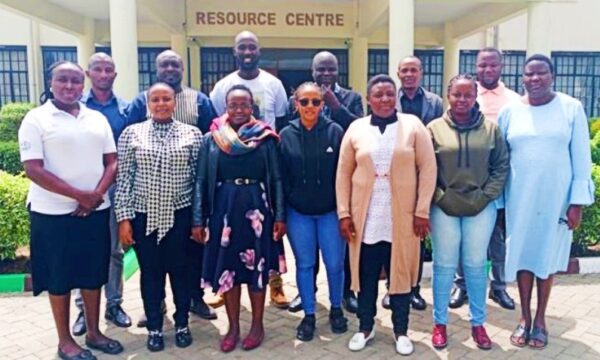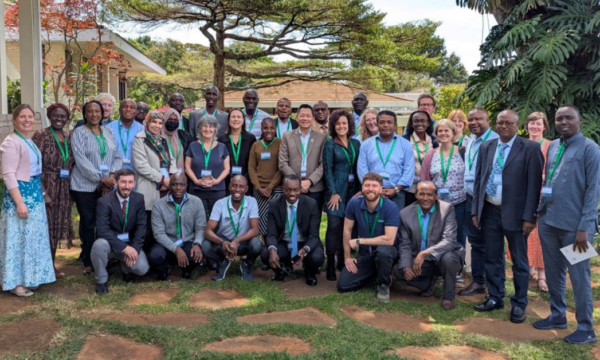
On 22nd May, we mark the International Day for Biological Diversity. Biodiversity is critical for life on Earth. We cannot live in isolation of our environment. But human activity is damaging essential habitats. In this article, CABI’s Global Director for Invasive Species Dr Hariet Hinz looks at how invasive woody weeds are harming biodiversity in East Africa and how sustainable weed control approaches can help to restore delicate but vital ecosystems.
Biodiversity loss is happening at an unprecedented rate. Earth.org reports that “biodiversity is declining faster than at any time in human history. The average abundance of native species in most major land-based habitats has fallen by at least 20% since 1900.”
But what does this mean for life on Earth? The uncomfortable truth, as explained in The Lancet, is that it “undermines ecosystems” abilities to function effectively and efficiently and this undermines nature’s ability to support a healthy environment.” Without this, we and other species cannot survive.
Biodiversity loss increases our vulnerability to climate change and limits options for climate adaptation. Ultimately, it threatens nature-based systems that are fundamental to our survival like food production.
Rural communities around the world that produce food are at most risk of biodiversity loss. Although the world’s poorest countries are home to the greatest array of biodiversity, they are now the ones bearing the brunt of the threat. We must take action today.
What causes biodiversity loss?
Invasive species are one of the major drivers of biodiversity loss. After habitat loss, they are the second greatest threat to biodiversity. Invasive species are living organisms, including plants, that have been moved from one part of the world to another, without their natural enemies, where they then spread and thrive.
They can have devastating effects on ecosystems. Take the woody shrub Prosopis juliflora, for example. In the 1970s, Prosopis was brought into Eastern Africa from the Americas as a source of fodder and wood, as well as a solution to reducing erosion on degraded land.
Today, it poses a significant threat to grasslands in East Africa. Its introduction has had unforeseen consequences as it has spread and crowded out native biodiversity. In the Afar region of Ethiopia, CABI scientists researched the spread of Prosopis. They discovered that the weed has encroached upon 1.2 million hectares of land during the past 35 years. This represents more than 14% of the region’s total area and is expected to continue to spread. In Afar, this growth has caused an 25% decrease in grasslands, which are critical ecosystems for wildlife and for absorbing carbon dioxide. The weed also consumes 50% of the average rainfall in the area; this thirsty plant worsens the effects of climate change.
Huge monocultures of Prosopis have harmed natural habits and the people who rely on them. Impacts include the loss of grazing land and access to water, a decline in biodiversity, reduced human health, and an increase in conflicts between humans and wildlife, as well as among humans themselves. In East Africa, the proliferation of woody weeds has had a significant negative impact on the livelihoods of pastoralists in Baringo County, Kenya.

Controlling woody weeds naturally
Farmers and land managers often turn to pesticides to try to control the spread of invasive weeds. But use of chemicals can have equally devastating effects on the environment. They can also harm human health. Manual removal of the weeds – of woody shrubs like Prosopis especially – can be incredibly difficult and labour intensive. Sometimes manual control can cause weeds to spread even further. But there is another way.
Nature-based solutions, like biocontrol, are effective alternatives to chemical controls and can address biodiversity loss. As a world leader in nature-based solutions, CABI has shown first-hand how natural approaches can control specific pests, diseases and weeds in a way that minimizes environmental harm.
Programmes to manage invasive species help to preserve and restore biodiversity. By contributing to, cataloguing, and conserving global biodiversity, we can safeguard ecosystems for the benefit of human and environmental wellbeing.
Woody Weeds+ – a project that can help to restore biodiversity
In the case of woody weeds, CABI is spearheading the Woody Weeds+ project, which builds upon previous project work and involves supporting the implementation of Kenya’s recently adopted National Prosopis Strategy, to which CABI has contributed. The aim is to enable sustainable management of woody weeds in Kenya.
The project generates and shares evidence-based knowledge about the impact and spread of these invasive plants on landscapes, as well as co-developing sustainable land management strategies to control them. By collectively addressing land degradation caused by woody weeds, the project supports communities, arming them with information to build local adaptive capacity and restore ecosystem services that are essential for coping with climate impacts.
Depending on the size of invasion and land assets, different management objectives (prevention, early detection rapid response (EDRR) or management), and different management techniques (surveillance, mechanical, chemical or biological control) will be implemented. While individual trees or small invasions can usually be best removed mechanically, biological control is the method of choice when the tree is already widespread. When biocontrol is unavailable, targeted use of chemical herbicides becomes necessary. The Woody Weeds+ project is setting up herbicide efficacy trials in Kenya’s Baringo and Isiolo Counties, applying them in very targeted ways.
In Tanzania, CABI is helping to protect habitats around Lake Manyara and Lake Natron from the prosopis invasion. Invasions around the Lake Natron basin are just starting, and visits to pastoralist communities here reveal just how important it is to prevent the spread of woody weeds to pasturelands.
What solutions help to prevent biodiversity loss?
Many solutions exist that can help to prevent biodiversity loss. As the Woody Weeds+ project demonstrates, an important first step is to understand the spread of invasive weeds. We can do this with field-based research that helps us to monitor changes in species distribution over time. We must find new ways to apply this work to help global conservation and monitoring efforts.
We can also work to minimize the disruption of ecosystems by invasive species. By documenting the spread of and threat from these species, we can help countries produce plans for their management. This means working across various landscapes with a range of organizations and stakeholders. The Woody Weeds+ project is a good example of bringing together people from local women’s groups to forestry researchers and land conservancies.
We can contribute to nature-based solutions through the identification, development, and release of new and safe biological control agents. This helps to protect biodiversity both by reducing the need for toxic pesticide use in agro-ecosystems and by supporting the restoration of ecosystems that have been degraded by invasion.
By working in partnership with governments, we can develop and implement landscape scale invasive species management strategies that reduce negative effects on biodiversity and ecosystem service delivery, while sustaining livelihoods. To achieve resilience, for example, the Woody Weeds+ project emphasizes the importance of inclusive governance approaches.
In relation to agriculture, we can promote nature-based solutions, including Integrated Pest Management (IPM). We can also increase the availability and use of low risk bioprotection products that conserve biodiversity.
Learn more about the Woody Weeds+ project here.
Learn more about our work on climate change and biodiversity here.
Additional information
Main image: Woody weeds in Baringo Country, Kenya (Credit: Sven Torfinn for CABI).
Project partners
Centre for Development and Environment (CDE), University of Bern, Switzerland (co-lead Woody Weeds +)
Centre for Training and Integrated Research in ASAL Development (CETRAD), Kenya
Kenya Forestry Research Institute (KEFRI), Kenya
University of Nairobi, Kenya
Tanzania Forest Research Institute (TAFORI), Tanzania (co-lead Darwin Initiative project DARCC013)
Tanzania Wildlife Management Authority (TAWA)
Community Research and Development Services (CORDS)
Related News & Blogs
Biodiversity loss: How can we reclaim our landscapes from threats to biodiversity?
On 22nd May, we mark the International Day for Biological Diversity. In this article, CABI’s Global Director for Invasive Species Dr Hariet Hinz looks at how we can reclaim our landscapes from threats to biodiversity. Biodiversity loss is proceeding at…
22 May 2025




